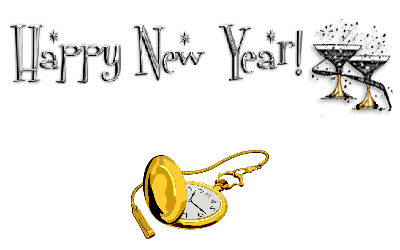

The New Year is an event that happens when a culture celebrates the end of one year and the beginning of the next. Cultures that measure yearly calendars have New Year celebrations. New Year's Eve is a celebration held the day before New Year's Day.
In the United States, cultural images include an old Father Time with a sash proclaiming the Old Year leaving as an infant with a sash proclaiming the New Year enters.
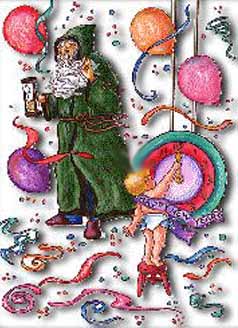
New Year's Eve is a separate observance from the observance of New Year's Day. In modern 20th century practice, the celebration involves partying until the moment of the transition of the year, generally at local midnight.
In the United States New Year's Eve is a major social holiday.
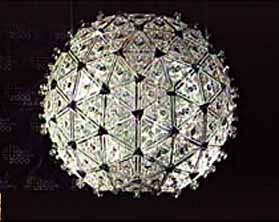
In New York City, the world famous 1,070-pound, 6-foot-diameter Waterford crystal ball on top of 1 Times Square in New York City is lowered starting at 11:59 PM and reaches the bottom of its tower at the stroke of midnight on January 1. In the past 100 years the dropping of the 'ball' , broadcast nationwide, is a major component of the celebration. Drinking champagne is also a major part. It is sometimes referred to as "the big apple" like the city itself; the custom derives from the time signal that used to be given at noon in harbors.
For about four decades Guy Lombardo and his Royal Canadians would serenade the nation from the ballroom of the Waldorf-Astoria hotel on Park Ave in New York. But every city in America has its own local version of the celebration, even while keeping an eye on New York, and the New York-centric aspect of the holiday is diminishing.
Within many cultures the use of fireworks and other noise making is a major part of the celebration.
Most New Year's Eves have passed with just festivities.
The major exception in current times was Y2K as the year 2000 began.
New Year's Eve is a public non-working holiday in the following countries, among others: Argentina, Brazil, Costa Rica, Germany, the Philippines, and Venezuela.
In Pasadena, California, the Tournament of Roses is held on New Year's Day with nearly a million revelers viewing the parade from the streets, with millions more around the world watching on television, followed by the Rose Bowl.
Many Americans make New Year's resolutions, or promises to themselves, which they hope to fulfill in the New Year that deal with self awareness and healing.
Immediately after the stroke of Midnight, the song Auld Lang Syne may be played and/or sung.
Chorus
For auld lang syne, my dear,
For auld land syne
We'll tak' a cup o' kindness yet
For auld lang syne.
We twa hae run about the braes
And pu'd the gowans fine
But we've wander'd mony a weary foot
Sin' auld lang syne.
We twa hae paidl't in the burn
Frae morning sun till dine
But seas between us braid hae roar'd
Sin' auld lang syne.
And surely ye'll be your pint stoup
And surely I'll be mine
And we'll tak' a cup o' kindness yet
For auld lang syne.
In Scotland, there are many special customs associated with the New Year. For more information, see the entry on Hogmanay, the Scots' name for the New Year celebration.
In The Netherlands and some other European countries, the New Year is greeted with massive private fireworks. The custom may have been imported by Chinese immigrants in the early 20th century. However, fireworks have long been part of the European celebration of major events, so this may not be so. This day is also the occasion to make bonfires of discarded Christmas trees in some countries.
Rosh Hashanah (Hebrew for 'head of the year') is a celebration that occurs 163 days following Pesach (Passover) In the Gregorian calendar at present, Rosh Hashanah cannot occur before September 5, when it occurred in 1899 and will occur again in 2013. After the year 2089, the differences between the Hebrew Calendar and the Gregorian Calendar will force Rosh Hashanah to be not earlier than September 6. Rosh Hashanah cannot occur later than October 5, when it occurred in 1967 and will again occur in 2043.
In the Bahç'ĺ calendar, the new year starts on March 21, called "Naw Ruz".
The Chinese New Year is generally celebrated with fire-crackers, and in some places with a parade. It falls at a new moon during the (Chinese) winter, i.e. the end of January or beginning of February.
The Telugu New Year generally falls in the months of March or April. The people of Andhra Pradesh, India celebrate the advent of Lunar year this day.
The Thai New Year is celebrated from April 13 to April 15 by throwing water.
The Vietnamese New Year is the TÉt Nguyen Dan. It is celebrated on the same day as Chinese New Year.
The ancient Roman calendar had only ten months and started the year on 1 March, which is still reflected in the names of some months which derive from Roman numerals: September (Seventh), October (Eighth), November (Ninth), December (Tenth). Around 715 BC the months of January, February and Mercedonius were added to the end of the year (Mercedonius only in leap years). Because consuls were chosen in January, and because years were named after the consuls who served in that year, January became the de facto beginning of the year.
In 45 BC, Julius Caesar introduced the Julian calendar, dropping Mercedonius and decreeing that the New Year should start on 1 January.
In the Middle Ages in Europe a number of significant feast days in the Ecclesiastical calendar of the Roman Catholic Church came to be used as the beginning of the year:
In Easter Style dating, the new year started on Easter Saturday (or sometimes on Good Friday). This was used in France from the 11th to the 16th century. A disadvantage of this system was that because Easter was a movable feast the same date could occur twice in a year; the two occurrences were distinguished as "before Easter" and "after Easter".
In Circumcision Style dating, the new year started on 1 January, the feast of the Circumcision. The ancient Roman new year of 1 March was used in the Republic of Venice until its destruction in 1797, and in Russia until the14th century.
1 September was used in Russia from the 14th century until the adoption of the Julian calendar.
Since the 17th century, the Roman Catholic ecclesiastic year has started on the first day of Advent, the Sunday nearest to St. Andrew's Day (30 November).
Autumnal Equinox Day is "New Year's Day" in the French Republican Calendar, which was in use from 1793 to 1805. The French First Republic was proclaimed and the French monarchy was abolished on September 21, 1792, making the following day, Autumnal Equinox Day that year, primidi VendemiĆre, the first day of the "Republican Era" in France.
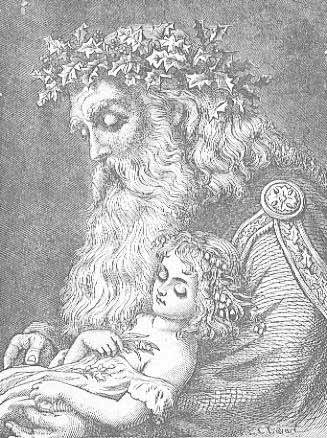
Father Time is a mythical personification of time. He is usually depicted as an elderly bearded man, dressed in a robe, carrying an hourglass or other timekeeping device (representing time's constant movement) and a scythe (linking time's passage with the inevitability of death).
This image is culled from several sources, including the Holly King, the Celtic god of the dying year, and Chronos, the Greek god of time.
As a popular New Year celebration, Father Time is also used as personification of the previous year, who "hands over" the duties of time to Baby New Year, who will also become Father Time, yielding to Baby New Year in a constant cycle.
Father Time is also seen in various books and movies helping Santa Claus stop time so he can deliver presents to the millions of homes across the world.A metal figure of Father Time sits proudly upon Lord's in North West London, which is the home of cricket and the MCC.
Because of their similarity in name as pertaining to parental figures, he is sometimes paired with Mother Nature as a married couple.
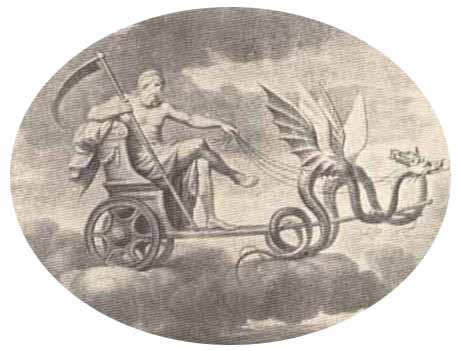
Chronos - Saturn
- Father Time
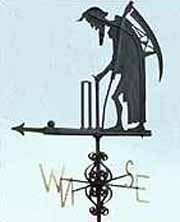
Chronos (also known as Chronus) is the personification of time itself. Indeed, the word means "time" and is the root of "chronology" and other modern words. It was, however, originally employed in a purely poetic sense. There is no God or Goddess directly associated with time per se in the annals of Greek mythology, but there may have been a Titan of Time.
Saturn (referred to by the Greeks as Cronus or Kronos) was the Roman Deity of Time and an ancient Italian Corn God known as the Sower. Male ruler of the Roman Gods prior to Jupiter, Saturn's weapon was a scythe or sickle.
The Romans honored Saturn at a MidWinter festival called Saturnalia, which lasted several days and at which there was much feasting and making merry. All business was suspended and schools were closed. Parents gave toys to their children and there was a public banquet. Saturn may have been worshiped by the pre-Hellenic population of the country but probably not widely revered by the Greeks themselves.
His functions were concerned with agriculture and his festival, held in Attica and known as Kronia, resembled the Roman Saturnalia in that it was a celebration of the harvest. In art, Saturn has always been depicted as a old man holding an implement which has often been interpreted as a harpe or curved sword, but which appears likely to have actually represented a scythe or a sickle.
Since ancient history, time has been identified with Saturn. In mythology, he was the son of Uranus (Heaven or Sky-Father) and Gaea (Earth-Mother) and the youngest of the Twelve Titans. Upon the advice of Gaea (who understood the changes of life and knew that Uranus would never, of his own accord, yield to the younger generation), Saturn castrated his father and thus separated Heaven from Earth. Gaea created out of flint...a mineral of her own substance...a sickle with which to complete the deed. It was the tool by which life was cut down at the time of harvest and was crescent-shaped like the moon, symbolic of cyclic rise and fall. It was believed that the spilled blood of Uranus formed such creatures as the Giants and the Furies, and that his genitals (which were tossed into the sea eventually produced the beautiful Venus/Aphrodite). Saturn's emasculation of Uranus now made Saturn King of the Titans and the rotation of the generations was thereby effected. Consequently, the sickle (and later, the scythe) became representative of the cruel and unrelenting flow of time which, in the end, cuts down all things.
After the demise of Uranus, Saturn took his sister, Rhea (Goddess of Necessity), as consort and together they ruled. She bore him five children: Vesta, Ceres, Juno, Pluto and Neptune...all of whom he swallowed because it had been foretold that he would be overthrown by his own child. When Jupiter was born, however, Rhea hid the baby in Crete and tricked Saturn into swallowing a stone wrapped in swaddling clothes instead. When Jupiter reached adulthood, he forced Saturn to disgorge his three sisters and two brothers. United, the siblings waged war and defeated their father. According to variations in the legend, Saturn was then either imprisoned in Tartarus or banished to Latium in Italy where he took refuge. According to some folktales, Jupiter, Neptune and Pluto were representative of Air, Water and Death...the three things that time itself cannot kill...and the overthrow of Saturn symbolized the demise of the old culture which worshiped this ancient God.'
Alternative legends maintain that Saturn became King of the Lost Golden Age and turned his attention to gardening, thus applying his sickle to less violent ends. A statue of Saturn holding his sickle once stood in the temple erected to the God on the road leading the Roman Capitol. This much wiser Saturn was an incorruptible deity and reigned supreme during a time when there were no wars or hardships.
He depicted fertility in its most exalted sense. Having learned his lesson, Saturn is said to have eventually stepped down in favor of his son, Picus (also known as Woodpecker) and retired altogether from human company. Some say that he now rules Elysium, the Isle of the Blest...others say he lies in a magic sleep, tended by nymphs, on an island near Britain and that he will one day return, bringing yet another Golden Age.
Saturn symbolizes the inexorable flow of time in both its destructive and constructive effects. His decrepit body is a reminder that time is the devourer of all things and that, like the substance in the hourglass he often carries, his physical vitality will run out until it is totally exhausted. However, just as the hourglass can be inverted, so a new generation restores the font of physical vitality.
Nonetheless, time is not wholly destructive, for the gift of time is the serenity and wisdom that are attainable only through the experiences of a long life. In addition, the white beard with which Saturn is frequently depicted indicates that age has given him a new purity and innocence.
The downward flow of the contents in the hourglass is balanced by an upward flow of spirit. Thus, the loss of vitality in the body is balanced by the increasing spiritualization of the mind, which gradually becomes filled less with earthly matters than those of the spirit. Saturn's flint sickle represents the harvest... cruel destruction for last year's crop, but nevertheless necessary to make room for the new crop in order to reap the fruits of the current harvest. In a similar fashion does the old crescent moon bring to finality the old cycle while being harbinger of a new one.
A modern notion of the relationship of time with Saturn or Kronos is that the association may have originated due to the confusion created by similar-sounding words ("Kronos" and "Chronos"). The image of the Grim Reaper bearing a scythe is believed to have derived directly from Kronos.
Both of these modern figures...Father Time and the Grim Reaper...are sometimes accompanied by a crow and there is speculation that the word "Chronos" and the subsequent associated God may have actually been representative of this bird, which was symbolic of both fertility and death. However, this hypothesis could again be as a result of confusion concerning similar-sounding words since the Latin for crow is "cornix." By the Middle Ages there were many engravings of the Grim Reaper which depict a skeletal figure holding a scythe and hourglass with a crow nearby.
Later, three Greek words added to the confusion of symbolic time: Chronus, which meant "time" itself; Kronos, the ancient Roman God of the Harvest; and Corone, the Greek word for crow. Whether these three were connected due to similar roots, or whether they were connected simply due to their similarity in sound is something which has yet to be proven. As with most mythological lore, the concepts tend to reach so far back into history that the origins cannot be reliably traced to any definitive conclusion.
New Year's Day is the first day of the year, in the Gregorian calendar. In modern times, it is January 1. In most countries, it is a holiday. It is still celebrated as a religious holy day on January 14 by those who still follow the Julian calendar such as followers of some of the Eastern Orthodox churches known as Old Calendarists.
January 1 marks the end of a period of remembrance of the passing year, especially in radio, television and the newspapers, which usually starts right after Christmas Day. Political parties, governments, sports teams, and other things such as new music and other artworks are rated by journalists, notable events are reevaluated in summaries in news sources, comedians get to reuse comedic material about news events again.
This day is traditionally a religious feast, but since the 1900s, has become an occasion to celebrate on the night between December 31 and January 1, called New Year's Eve. There are often fireworks at midnight. Depending on the country, individuals may be allowed to burn fireworks, even if it is forbidden the rest of the year.
It is also an occasion to make New Year resolutions, the most popular ones in the western world include to stop tobacco smoking or drinking, or to lose weight or get physically fit.
In the United Kingdom, New Year's Day is a public holiday; if it falls on a Saturday or Sunday then the Monday will be a public holiday.
Among the 7th century druidic pagans of Flanders, it was the custom to exchange gifts at New Year's, a pagan custom deplored by Saint Eligius (died 659/60), who would warn the Flemings, "[Do not] make vetulas, [little figures of the Old Woman], little deer or iotticos or set tables [for the house-elf, compare Puck] at night or exchange New Years' gifts or supply superfluous drinks [another Yule custom]." The quote is from the vita of Eligius written by his companion Ouen.
In the Middle Ages, most European countries used the Julian calendar. By this method, the Feast of the Annunciation or Lady Day as it was called, was celebrated on March 25. This celebration was to honour the day that the angel Gabriel announced to Mary that she would give birth to a son, Jesus. This is exactly nine months before what is now Christmas Day.
In 1582, the Gregorian calendar was introduced, and Roman Catholic countries began to celebrate New Year's Day on January 1. This calendar heralded a slow but gradual introduction, Scotland in 1600; Germany, Denmark and Sweden about 1700; then Britain and its colonies in 1752.
The Chinese celebrate New Year's Day sometime between January 10 and February 19 of the Gregorian calendar. Each year is symbolized by one of twelve animals, on an even recurring pattern. It is their most important holiday.